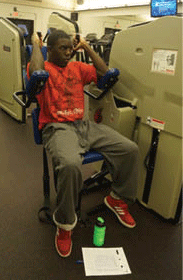By Jeffrey Wallace Richman
The Scene staff

Most future students at St. Louis Community College won’t have to take the two credits of physical education that are required of current students.
The STLCC Board of Trustees recently voted 4-3 to make the change, based on a proposal from the College Academic Council and a task force that included faculty members.
Officials argued that the P.E. requirement kept some students from graduating and hurt the college financially. The state of Missouri provides state funding based on performance, including graduation rates.
“I think it puts us in line with where the national trend is,” said Andrew Langrehr, the college’s vice chancellor for academic affairs.
In 2011, nearly 50 percent of STLCC students who were close to graduating and who transferred to other institutions hadn’t completed the two P.E. credits of P.E., according to district records.
The council also found that more than 85 percent of transfer students who start at STLCC end up graduated from a four-year institution that doesn’t have a P.E. or wellness requirement.
“None of the Top 5 schools that take St. Louis Community College graduates have the requirement,” Lengrehr said.
The change isn’t good news for P.E. programs on STLCC campuses, which may eventually may decrease the number and variety of classes.
Mark Applegate, P.E. department chair and assistant professor at Forest Park, notes that physical education helps students stay healthy and reduce stress.
A vocal opponent of the change was STLCC retiree Bob Nelson, 78, of Kirkwood, a longtime basketball coach and P.E. teacher and later a Board of Trustees member.
“When Nelson heard the board was planning to cut the P.E. graduation requirement, he went to Facebook and fired up his Rolodex and started an email campaign to stop the change in its tracks,” a St. Louis Post-Dispatch columnist reported.
“It’s really a sad situation,” Nelson was quoted as saying. “Our society is fat. We’re overweight, and we need physical education.”

STLCC students enrolling for the first time this fall won’t have to take P.E. classes, unless their majors or programs require it.
The P.E. requirement will stay in place for students who have already been attending Forest Park.
“I think it is important to note that the requirement isn’t gone,” Applegate said. “As of right now, all students are still required to take two credits of P.E.”
Students can choose from 17 classes, ranging from Dance Aerobics to Beginning Rock Climbing, Swimming to Walking for Fitness, Stress Management to First Aid.
STLCC programs created from this point on won’t have the P.E. requirement. Existing programs will have it until officials go through a formal curriculum process to remove it.
“It could (become) a problem in the future if students believe that it’s eliminated, but in their current program, it’s not,” Applegate said.
Forest Park students seem to have mixed feelings about the change.
Nursing major Thalia Bates, 18, believes it will have a negative effect on students with busy schedules and weight problems. P.E. classes may be their only form of exercise.
“I think (taking P.E.) lowers students’ stress levels, so taking away that requirement will make them more stressed,” she said.
Baking and pastry arts major Jackie Huddleston, 17, said the change will alleviate discomfort for overweight or non-athletic students who don’t like going to thegym because they don’t fit in.
“I personally have always hated P.E., so it forces me to (take a class) and get a credit,” she said.
Business major Tamia Houston, 18, sees good and bad in the P.E. requirement. She knows it’s important for college students to stay active because of all the “obesity and laziness in America.”
On the other hand, Houston sees a possible benefit in eliminating the P.E. requirement: It might free up more time for students to be involved in clubs and other organizations or take more academic classes.
“If I didn’t have to take P.E., then I would take business courses that apply to my major,” she said.
